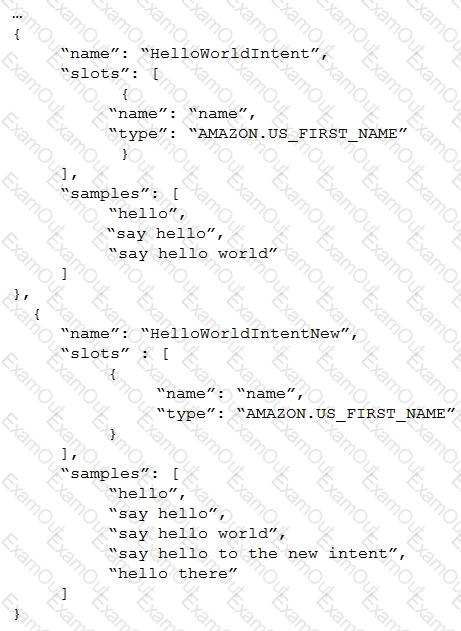An Alexa Skill Builder is designing a skill with an intent that needs six slots to be filled. It is unlikely that a user
will provide all the slot values in a single utterance, so the slot fulfillment should be split up into a multi-turn
conversation.
What can the Builder do in the developer console to have Amazon Alexa elicit any missing slots, without
specifying each of the slots in the backend code?
What are the prerequisites for implementing account linking for Amazon Alexa smart home skills?
The information below details a portion of an interaction model in JSON:

What is wrong with this interaction model?
An Alexa Skill Builder is using session attributes to maintain a user’s state.
What can the Builder do to ensure that a user’s session is not lost if they take too long to answer a question and the skill exists?
An Alexa Skill Builder is developing a custom skill and needs to verify that the correct slot values are being
passed into the AWS Lambda function.
According to best practices, what is the MOST efficient way to capture this information?
An Alexa Skill Builder needs to display an image and some additional text to users of a skill.
Which approach will work with any Amazon Alexa enabled device?
An Alexa Skill Builder wants to create a skill that asks the user two yes/no QUESTION NO:s:
Alexa:Do you like cats?
Alexa:Do you like dogs?
When the username answers “yes”, how should the Builder code the handler to know which QUESTION NO: the
answer refers to?
An Alexa Skill Builder built a skill using AWS LambdA. The Lambda function works when running the code on
a local machine with a runtime of 4.5 seconds, but during skill testing, the Builder receives an error response.
Which collection of steps will address the issue? (Choose two.)
An Alexa Skill Builder needs to have knowledge of the previous prompt that was presented to the user in order
to give context to the user’s response.
How can the Builder accomplish this?

